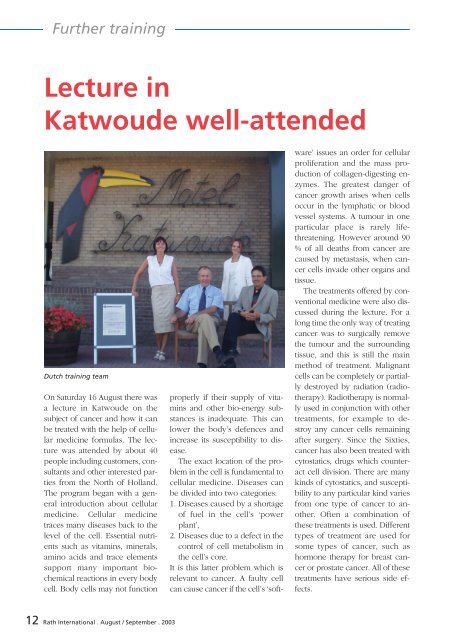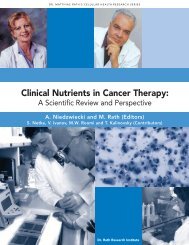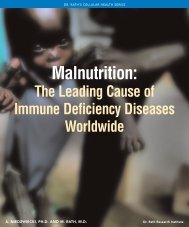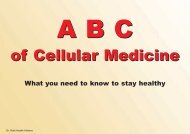Portrait - Dr. Rath Health Alliance
Portrait - Dr. Rath Health Alliance
Portrait - Dr. Rath Health Alliance
You also want an ePaper? Increase the reach of your titles
YUMPU automatically turns print PDFs into web optimized ePapers that Google loves.
12<br />
Further training<br />
Lecture in<br />
Katwoude well-attended<br />
Dutch training team<br />
On Saturday 16 August there was<br />
a lecture in Katwoude on the<br />
subject of cancer and how it can<br />
be treated with the help of cellular<br />
medicine formulas. The lecture<br />
was attended by about 40<br />
people including customers, consultants<br />
and other interested parties<br />
from the North of Holland.<br />
The program began with a general<br />
introduction about cellular<br />
medicine. Cellular medicine<br />
traces many diseases back to the<br />
level of the cell. Essential nutrients<br />
such as vitamins, minerals,<br />
amino acids and trace elements<br />
support many important biochemical<br />
reactions in every body<br />
cell. Body cells may not function<br />
<strong>Rath</strong> International . August / September . 2003<br />
properly if their supply of vitamins<br />
and other bio-energy substances<br />
is inadequate. This can<br />
lower the body’s defences and<br />
increase its susceptibility to disease.<br />
The exact location of the problem<br />
in the cell is fundamental to<br />
cellular medicine. Diseases can<br />
be divided into two categories:<br />
1. Diseases caused by a shortage<br />
of fuel in the cell’s ‘power<br />
plant’,<br />
2. Diseases due to a defect in the<br />
control of cell metabolism in<br />
the cell’s core.<br />
It is this latter problem which is<br />
relevant to cancer. A faulty cell<br />
can cause cancer if the cell’s ‘soft-<br />
ware’ issues an order for cellular<br />
proliferation and the mass production<br />
of collagen-digesting enzymes.<br />
The greatest danger of<br />
cancer growth arises when cells<br />
occur in the lymphatic or blood<br />
vessel systems. A tumour in one<br />
particular place is rarely lifethreatening.<br />
However around 90<br />
% of all deaths from cancer are<br />
caused by metastasis, when cancer<br />
cells invade other organs and<br />
tissue.<br />
The treatments offered by conventional<br />
medicine were also discussed<br />
during the lecture. For a<br />
long time the only way of treating<br />
cancer was to surgically remove<br />
the tumour and the surrounding<br />
tissue, and this is still the main<br />
method of treatment. Malignant<br />
cells can be completely or partially<br />
destroyed by radiation (radiotherapy).<br />
Radiotherapy is normally<br />
used in conjunction with other<br />
treatments, for example to destroy<br />
any cancer cells remaining<br />
after surgery. Since the Sixties,<br />
cancer has also been treated with<br />
cytostatics, drugs which counteract<br />
cell division. There are many<br />
kinds of cytostatics, and susceptibility<br />
to any particular kind varies<br />
from one type of cancer to another.<br />
Often a combination of<br />
these treatments is used. Different<br />
types of treatment are used for<br />
some types of cancer, such as<br />
hormone therapy for breast cancer<br />
or prostate cancer. All of these<br />
treatments have serious side effects.









